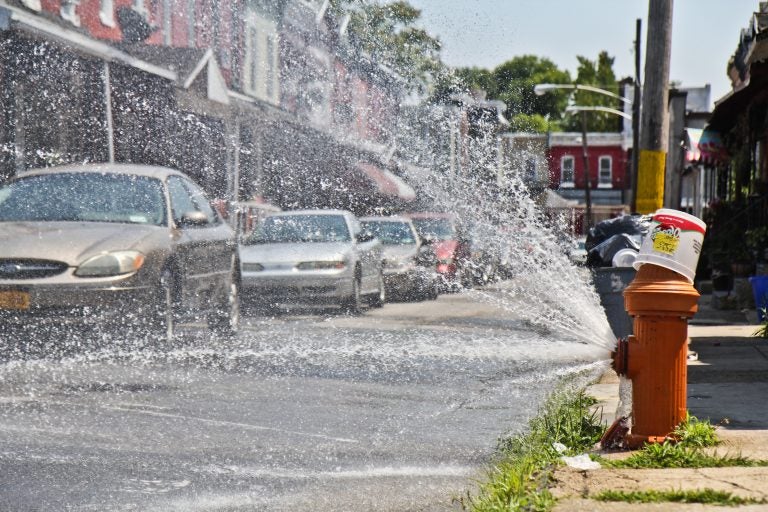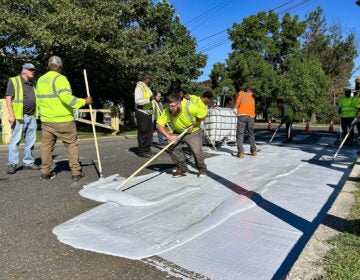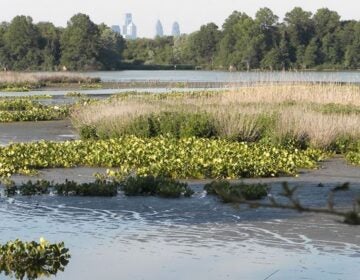A deadly hot summer is coming. Philly doesn’t yet have a plan.
The communities hit hardest by the coronavirus are also the most at risk during the extreme heat expected to come this summer, epidemiologists say.

File photo: Fire hydrants were opened around the city during an historic heatwave in Philadelphia in 2018. NOAA predicts higher-than-average temperatures for Philadelphia for the summer of 2022. (Kimberly Paynter/WHYY)
Gabriella Paez is not looking forward to this summer.
She’s a coordinator at Esperanza, an organization working with the Latinx community in Hunting Park — one of Philadelphia’s hottest neighborhoods, where temperatures regularly climb 22 degrees higher than those in greener parts of the city.
“It’s definitely a very challenging year,” Paez said. “It’s not only that we know the heat is coming and it will affect our residents, like it affects them every year, but now we have an added challenge of COVID-19.”
Weather forecasts predict temperatures higher than normal and possible heat waves for this summer. With public pools closed for the season and limited access to recreation centers and air-conditioned public spaces such as libraries, elderly people, kids and other vulnerable populations are at a higher risk for deadly heat illnesses — especially in lower-income neighborhoods like Hunting Park, which according to city studies, are also the hottest, have higher rates of asthma, and less access to trees, green areas, air conditioners and cooling centers. And now, higher rates of coronavirus, too.
As with heat, low-wage workers and communities of color have been disproportionately affected by COVID-19. Hunting Park, or zip code 19140, is one of the areas more heavily affected by the pandemic, with 800 cases recorded so far. Without safeguards against the heat in place, the compounding risk factors could lead to an increase of fatalities within these vulnerable communities, epidemiologists say.
“Noticeably, the groups that are at higher risk for the increased illness and death associated with extreme heat are very similar to the groups that are at high risk for poor outcomes with COVID-19, with the exception of the young children,” said Yvonne Michael, a Harvard School of Public Health epidemiologist teaching at Drexel University’s School of Public Health.
Exposure to extreme heat can result in hyperthermia, which can result in death. Heat-related deaths have decreased in Philadelphia in recent decades, but fatalities caused by heatstroke or heat exhaustion continue to occur. Hyperthermia occurs when the body is unable to cool itself and the body temperature starts rising rapidly in response to prolonged hot and humid weather. If a person is unable to move into a cooler space or seek emergency care, extreme heat can damage the brain and other vital organs, like the heart or the kidneys, and it can make other existing conditions worse.
People over 60 and children younger than 5 are at the highest risk for heat illnesses, according to Michael, as well as those who suffer other medical conditions such as obesity, diabetes and heart disease. Isolated people are also at high risk.
“So at a time when we’re seeing elevated deaths already in these same groups, due to the coronavirus, you might expect to see even higher levels of fatalities in those groups,” Michael said.
Limited cooling options
Although city officials recognize this will be a challenging summer, Philadelphia has not yet come up with a heat plan that takes into consideration the limitations presented by the coronavirus pandemic.
Usually, when the city declares a heat emergency, a number of services get activated to keep people cool and safe from the dangers of extreme heat. Cooling centers or air-conditioned public spaces stay open longer, the city increases its outreach to homeless people, and a special heatline, managed by the Philadelphia Corporation for Aging, connects residents with nurses who can help them either by phone or in person.
But many of those services will be compromised by coronavirus-induced restrictions or by budget cuts proposed by the mayor to recover from the pandemic’s costs. Cooling centers, for example, usually operate out of libraries, senior centers and rec centers. All of those are currently closed with unclear plans for reduced-hours reopenings.

Subscribe to PlanPhilly
Since 2017, the city has declared one heat emergency every year. But Chris Gallagher, director of PCA’s Helpline, which includes the heatline, said the number of days within the emergency gets higher every year, with two days in 2017, four days in 2018 and six days in 2019.
“This summer is going to be a little bit tricky,” Gallagher said.
“It will obviously be an unusual summer,” said Christine Knapp, director of the city’s Office of Sustainability.
Knapp has been working for years with the city’s Department of Public Health and the Office of Emergency Management on strategies to mitigate heat. She said the plan for this summer is in the works and will probably be published by the end of the month. Last year the city debuted its first community plan to beat rising temperatures in Hunting Park, which included different tools to help residents stay safe during heat events.
“But a lot of those tools will now [may not] be able to be used or will have to be modified in order to work when we will have, maybe, stay-at-home orders or at least social distancing requirements in effect,” Knapp said.
Which is why community advocates are hoping the city considers non-traditional alternatives to keep vulnerable populations cool and safe.
Clear Air Council’s Russell Zerbo, who has been working with the city and other groups on heat workshops since 2017, said the city should be thinking of using large venues, like the airport and hotels, that were used during the height of COVID-19.
“I would like the same approach to extreme heat that we had during the early days of the quarantine,” Zerbo said.
Two weeks ago, New York City announced its heat plan for this year, which includes the creation of cooling centers in sport venues and auditoriums (with the proper space for physical distance and use of personal protective equipment) and transportation to those centers during extreme heatwaves. The city is also planning to use hotels for emergency shelter during prolonged power outages caused by the heat.
Knapp said hotels or the airport are not a thought in Philadelphia. But stadiums, gymnasiums or big churches could be used to keep people cool.
Keeping people cool inside their homes
Recent research shows that heat won’t end the coronavirus pandemic, as many have hoped. The virus’ persistence instead, according to Drexel’s Michael, will put people — especially vulnerable populations — in a conundrum.
“With the high heat, we would encourage people to not stay inside their homes, especially if they don’t have air conditioning. But with the coronavirus, we’re encouraging people to stay away from the public spaces,” Michael said.
“So the recommendations for these same people are in conflict, which may be confusing in terms of how to protect themselves or to be protected. But also may lead to an increased number of deaths.”
According to the city’s community heat plan in Hunting Park, only 5% of a group surveyed — with most participants younger than 65 years old — didn’t have an air conditioner. But 61% said they always use it when it’s very hot outside, and 77% said having access to air conditioning or fans would help to feel cooler inside their homes.
Sophie Sarkar, an urban planner and community organizer working with communities of color, worked on the city’s Hunting Park heat resilience plan as the Office of Sustainability’s Equity Fellow.
“I think the city could invest in getting folks air conditioning,” said Sarkar. “And then getting them assistance with their air conditioning bills.”
New York City’s heat plan contemplates a $55 million program to give 74,000 air conditioners to low-income residents over 60 years old.
Philadelphia’s Knapp said giving air conditioners to those who need them the most is one of the things the city would like to do this summer.
“The big question is how you pay for it,” she said.
Knapp is thankful that the Pennsylvania Department of Human Services enabled the Low-Income Home Energy Assistance Program (LIHEAP) to be available for the summer, something for which her office has been advocating over several years.
The program traditionally helps lower-income families to pay for their energy bills during the winter, but recently announced a recovery crisis program in response to COVID-19 that will provide up to $800 per household and run through the end of August or until funds are exhausted.
Knapp said her office is also looking at more effective ways to provide information to people on how to prevent heat diseases and what to do when they experience symptoms. Less traditional solutions under consideration include providing energy-saving light bulbs or blackout curtains to residents, or adding water and other cooling alternatives to food distribution sites during the summer.
Esperanza’s Paez hopes one of those solutions is distributing fans.
“Our neighbors don’t even have air conditioning, a lot of them, so a fan may help,” she said.
 WHYY is one of over 20 news organizations producing Broke in Philly, a collaborative reporting project on solutions to poverty and the city’s push towards economic justice. Follow us at @BrokeInPhilly.
WHYY is one of over 20 news organizations producing Broke in Philly, a collaborative reporting project on solutions to poverty and the city’s push towards economic justice. Follow us at @BrokeInPhilly.
WHYY is your source for fact-based, in-depth journalism and information. As a nonprofit organization, we rely on financial support from readers like you. Please give today.






![CoronavirusPandemic_1024x512[1]](https://whyy.org/wp-content/uploads/2020/03/CoronavirusPandemic_1024x5121-300x150.jpg)


